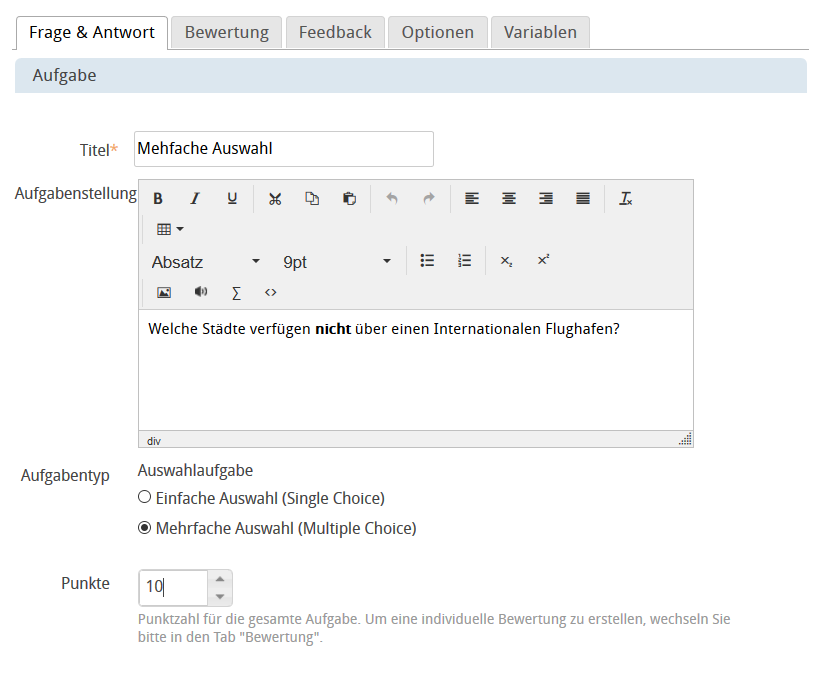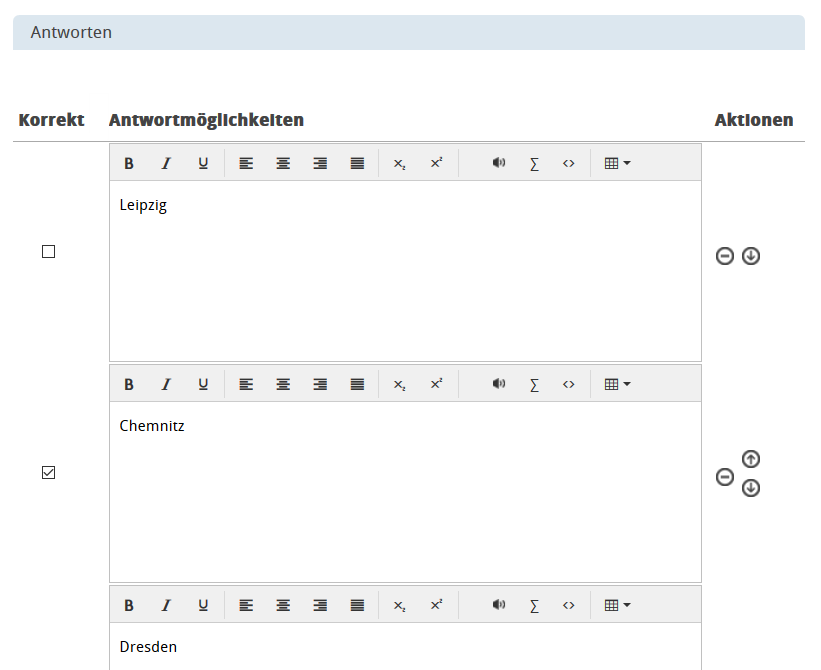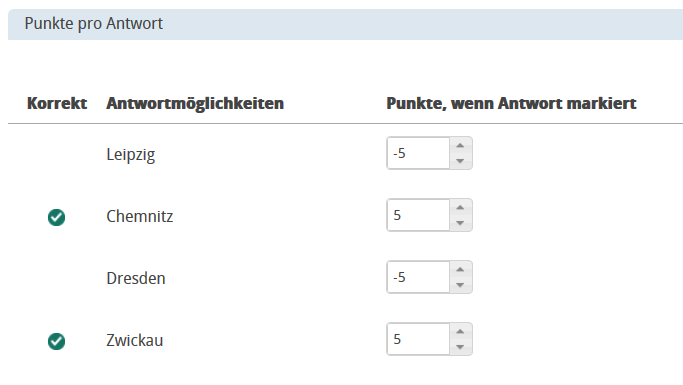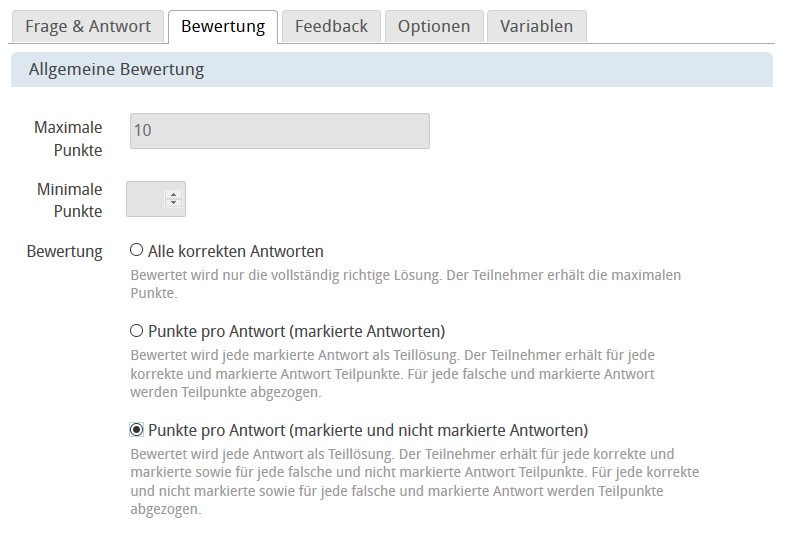Individuelle Bewertung von Auswahlaufgaben
Auswahlaufgaben zeigen dem Teilnehmer verschiedene Antwortoptionen, aus welchen eine oder mehrere richtige Antworten ausgewählt werden können. Neben der klassischen Auswahlaufgabe (Single und Multiple Choice) stehen die Aufgabentypen Hotspotaufgabe und Fehlertextaufgabe als spezielle Auswahlaufgaben (bzw. Aufgaben im Antwort-Wahl-Verfahren) zur Verfügung.
Für Auswahlaufgaben stehen Ihnen folgende Bewertungsmöglichkeiten zur Verfügung:
- Automatische Bewertung:
- Alle korrekten Antworten
Bewertet wird nur die vollständig richtige Lösung. Der Teilnehmer erhält die maximalen Punkte. - Punkte pro Antwort (markierte Antworten)
Bewertet werden alle Antwortoptionen, die der Teilnehmer markiert hat. Für richtig markierte Antworten können Teilpunkte vergeben und für falsche Antworten abgezogen werden. - Punkte pro Antwort (markierte und nicht markierte Antworten)
Bewertet werden alle Antwortoptionen der Aufgabe, die der Teilnehmer markieren könnte. So können neben den tatsächlich markierten Antworten auch nicht markierte Antworten bewertet werden.
- Alle korrekten Antworten
- Manuelle Bewertung
Allgemeine Bewertung
Inhalt
Betroffene Aufgabenformate
Alle korrekten Antworten
Bei der Bewertung Alle korrekten Antworten erfolgt eine automatische Bewertung nach dem Richtig/Falsch-Prinzip. Löst der Teilnehmer die Aufgabe vollständig richtig, erhält er die maximale Punktzahl. Löst der Teilnehmer die Aufgabe falsch, erhält er 0 Punkte.
Eine Auswahlaufgabe gilt als vollständig richtig gelöst, wenn durch den Teilnehmer alle Antwortoptionen gewählt werden, die durch den Autor als korrekt markiert wurden. Es darf keine der Antwortoptionen gewählt werden, die nicht als korrekt markiert wurden.
Beispiel "Mehrfache Auswahl" - Bewertung "Alle korrekten Antworten"
Im Beispiel wird die Bewertung einer Auswahlaufgabe mit mehreren korrekten Antworten (Mehrfache Auswahl) eingestellt. Der Teilnehmer soll nur Punkte erhalten, wenn er die Aufgabe vollständig richtig löst. Enthält seine Antwort einen Fehler, erhält der Teilnehmer keine Punkte (0 Punkte).
Die Bewertung Alle korrekten Antworten ist als Standardauswertung vorkonfiguriert. Alle notwendigen Einstellungen können durch den Autor im Tab Frage & Antwort vorgenommen werden.
| Legen Sie zunächst die Punkte für die Auswahlaufgabe fest. Löst der Teilnehmer die Aufgabe vollständig richtig, erhält der Teilnehmer die von Ihnen festgelegten Punkte. Im Beispiel werden 10 Punkte vergeben. |
| Legen Sie die möglichen Antwortoptionen für die Auswahlaufgabe fest und welche der gegebenen Antworten korrekt sind. Um eine Antwort als korrekt und damit als richtige Antwortoption festzulegen, selektieren Sie die Checkbox vor der Antwortoption. Im Beispiel werden die Antwortmöglichkeiten "Chemnitz" und "Zwickau" als korrekt markiert. |
| In der Aufgabenvorschau können Sie die Bewertung erproben. Im Beispiel erhält der Teilnehmer die festgelegten 10 Punkte nur, wenn er die Antwortmöglichkeiten "Chemnitz" und "Zwickau" auswählt. Wählt der Teilnehmer nur eine der korrekten Antworten oder weitere nicht korrekte Antworten, erhält er 0 Punkte. |
Punkte pro Antwort (markierte Antworten)
Bei der Bewertung Punkte pro Antwort (markierte Antworten) können für jede vom Teilnehmer gewählte Antwortmöglichkeit Teilpunkte vergeben werden. Für eine korrekte Antwort, die der Teilnehmer markiert hat, können Pluspunkte vergeben werden. Für falsche Antworten, die der Teilnehmer markiert hat, können Minuspunkte vergeben werden.
Die Bewertung Punkte pro Antwort bzw. Punkte pro Antwort (markierte Antworten) können Sie im Tab Bewertung einstellen. Wählen Sie die Option, öffnet sich automatisch der Bereich Individuelle Bewertung , wo Sie die Teilpunkte pro Antwortmöglichkeit einstellen können. Das System schlägt automatisch eine Punktevergabe auf Basis der zuvor definierten maximalen Gesamtpunktzahl der Aufgabe vor. Diese können Sie einzeln ändern und Ihren Bedürfnissen anpassen.
Entsprechend der allgemeinen Bewertungseinstellung können die minimalen und maximalen Punktwerte nicht überschritten werden. Vergeben Sie Minuspunkte für einzelne Antworten, fällt die Gesamtpunktzahl der Aufgabe niemals negativ aus, sondern wird auf minimal 0 Punkte gesetzt.
Beispiel "Mehrfache Auswahl" - Bewertung "Punkte pro Antwort (markierte Antworten)"
Im Beispiel wird die Bewertung einer Auswahlaufgabe mit mehreren korrekten Antworten (Mehrfache Auswahl) eingestellt. Der Teilnehmer soll für jede korrekte und markierte Antwort fünf Punkte erhalten. Für jede falsche und vom Teilnehmer markierte Antwort sollen dem Teilnehmer fünf Punkte abgezogen werden.
| Wählen Sie zunächst im Tab Bewertung die Bewertungsmöglichkeit Punkte pro Antwort (markierte Antworten) . Es öffnet sich automatisch der Abschnitt Individuelle Bewertung , wo sie die Bewertung individuell anpassen können. |
| Entsprechend der von Ihnen konfigurierten maximalen Punkte wird durch das System eine Bewertung der einzelnen Antworten vorgeschlagen. Im Beispiel waren die maximalen Punkte auf 10 Punkte festgelegt. Das System verteilt diese Punkte automatisch auf alle korrekten Antworten. Da es zwei korrekte Antworten gab, werden für jede korrekte Antwort 5 Punkte (Pluspunkte) festgelegt. Zusätzlich werden die Minuspunkte für falsch markierte Antworten festgelegt. Auch hier verteilt das System entsprechend der maximalen Punkte -10 Punkte automatisch auf alle falschen Antworten. Da es zwei falsche (nicht als korrekt markierte) Antworten gab, werden für jede falsche Antwort -5 Punkte (Minuspunkte) festgelegt. Bitte beachten Sie, dass die Vergabe von Minuspunkten für falsche (und markierte) Antworten unbedingt zu empfehlen ist. Da nur vom Teilnehmer markierte Antworten bewertet werden, erhält der Teilnehmer ohne die Vergabe von Minuspunkten immer die maximalen Punkte, wenn er alle Antworten wählt. |
In der Aufgabenvorschau können Sie die Bewertung erproben. Im Beispiel erhält der Teilnehmer die maximalen 10 Punkte nur, wenn er die Antwortmöglichkeiten "Chemnitz" und "Zwickau" auswählt. Wählt der Teilnehmer nur eine der korrekten Antworten oder weitere nicht korrekte Antworten erhält er Teilpunkte oder 0 Punkte. Wählt der Teilnehmer nur eine der korrekten Antworten, beispielsweise "Chemnitz", erhält er 5 von 10 möglichen Punkten. Der Teilnehmer erhält Teilpunkte, da er die korrekte Antwort "Chemnitz" (+ 5 Punkte) markiert hat. Die nicht markierten Antworten "Leipzig", "Dresden" und "Zwickau" werden nicht bewertet (0 Punkte). Wählt der Teilnehmer beide korrekten Antworten ("Chemnitz" und "Zwickau") und zusätzlich eine falsche Antwortoption, beispielsweise "Dresden", erhält er 5 von 10 möglichen Punkten. Der Teilnehmer erhält Teilpunkte, da er die korrekten Antworten "Chemnitz" (+ 5 Punkte) und "Zwickau" (+ 5 Punkte) markiert hat. Für die Markierung der falschen Antwort "Dresden" bekommt er von diesen erreichten Pluspunkten Teilpunkte abgezogen (- 5 Punkte). | |
Die minimale Punktzahl ist für alle Aufgaben standardmäßig auf 0 Punkte eingestellt. Trotz Vergabe von Minuspunkten für einzelne Antworten, fällt die Gesamtpunktzahl der Aufgabe niemals negativ aus, sondern wird auf minimal 0 Punkte gesetzt. |
Punkte pro Antwort (markierte und nicht markierte Antworten)
Bei der Bewertung Punkte pro Antwort (markierte und nicht markierte Antworten) können für alle Antwortmöglichkeiten, entsprechend ob diese vom Teilnehmer gewählt oder nicht gewählt (markiert) wurden, Teilpunkte vergeben werden. Für eine korrekte Antwort, die der Teilnehmer markiert hat, sowie für eine falsche Antwort, die der Teilnehmer nicht markiert hat, können Pluspunkte vergeben werden. Zusätzlich können optional Minuspunkte für korrekte, aber vom Teilnehmer nicht markierte bzw. falsche, aber vom Teilnehmer markierte Antworten vergeben werden.
Die Bewertung Punkte pro Antwort (markierte und nicht markierte Antworten) können Sie im Tab Bewertung einstellen. Wählen Sie die Option, öffnet sich automatisch der Bereich Individuelle Bewertung, wo Sie die Teilpunkte pro Antwortmöglichkeit einsehen können. Das System schlägt automatisch eine Punktevergabe auf Basis der zuvor definierten maximalen Gesamtpunktzahl der Aufgabe vor. Sie können frei konfigurieren, ob Minuspunkte vergeben werden sollen oder nicht.
Entsprechend der allgemeinen Bewertungseinstellung können die minimalen und maximalen Punktwerte nicht überschritten werden. Vergeben Sie Minuspunkte für einzelne Antworten, fällt die Gesamtpunktzahl der Aufgabe niemals negativ aus, sondern wird auf minimal 0 Punkte gesetzt.
Beispiel "Mehrfache Auswahl" - Bewertung "Punkte pro Antwort (markierte und nicht markierte Antworten)"
Im Beispiel wird die Bewertung einer Auswahlaufgabe mit mehreren korrekten Antworten (Mehrfache Auswahl) eingestellt. Pro richtiger Teilantwort sollen 2,5 Punkte vergeben werden. Für eine falsche Teilantwort sollen 2,5 Punkte abgezogen werden.
| Wählen Sie zunächst im Tab Bewertung die Bewertungsmöglichkeit Punkte pro Antwort (markierte und nicht markierte Antworten) aus. Es öffnet sich automatisch der Abschnitt Individuelle Bewertung, wo sie die Bewertung individuell anpassen können. |
| Entsprechend der von Ihnen konfigurierten maximalen Punkte wird durch das System eine Bewertung der einzelnen Antworten vorgeschlagen. Im Beispiel waren die maximalen Punkte auf 10 Punkte festgelegt. Das System verteilt diese Punkte automatisch auf alle Antworten. Da es vier Antwortmöglichkeiten gab, werden für jede Teilantwort 2,5 Punkte (Pluspunkte) festgelegt. Bitte beachten Sie, dass die Ratewahrscheinlichkeit steigt, wenn die Vergabe von Minuspunkten nicht aktiviert wird. Die Ratewahrscheinlichkeit sollte beim Festlegen der notwendigen Punkte zum Bestehen bedacht werden. Detaillierte Informationen zum Thema "Ratewahrscheinlichkeit bei Multple-Choice-Fragen" finden Sie u.a. unter Item-Ratekorrektur (TU Dresden) , Multiple-Choice-Prüfungen (Wie Sie die Ratewahrscheinlichkeit minimieren) (TU München) , Prüfungen im Multiple-Choice-Verfahren (Hochschule Ludwigshafen am Rhein) . |
| In der Aufgabenvorschau können Sie die Bewertung erproben. Im Beispiel erhält der Teilnehmer die maximalen 10 Punkte nur, wenn er die Antwortmöglichkeiten "Chemnitz" und "Zwickau" auswählt. Wählt der Teilnehmer nur eine der korrekten Antworten oder weitere nicht korrekte Antworten, erhält er Teilpunkte oder 0 Punkte. Wählt der Teilnehmer nur eine der korrekten Antworten, beispielsweise "Chemnitz", erhält er 5 von 10 möglichen Punkten. Der Teilnehmer erhält Teilpunkte, da er die korrekte Antwort "Chemnitz" (+ 2,5 Punkte) markiert hat und da er die falschen Antworten "Leipzig" (+ 2,5 Punkte) und "Dresden" nicht markiert hat (+ 2,5 Punkte). Da er die korrekte Antwort "Zwickau" (- 2,5 Punkte) nicht markiert hat, werden Teilpunkte von den erreichten Pluspunkten abgezogen. Wählt der Teilnehmer beide korrekten Antworten ("Chemnitz" und "Zwickau") und zusätzlich eine falsche Antwortoption, beispielsweise "Dresden", erhält er 5 von 10 möglichen Punkten. Der Teilnehmer erhält Teilpunkte, da er die korrekten Antworten "Chemnitz" (+ 2,5 Punkte) und "Zwickau" (+ 2,5 Punkte) markiert hat und da er die falsche Antwort "Leipzig" nicht markiert hat (+ 2,5 Punkte). Da er die falsche Antwort "Dresden" (- 2,5 Punkte) ebenfalls markiert hat, werden Teilpunkte von den erreichten Pluspunkten abgezogen. |
Die minimale Punktzahl ist für alle Aufgaben standardmäßig auf 0 Punkte eingestellt. Trotz Vergabe von Minuspunkten für einzelne Antworten, fällt die Gesamtpunktzahl der Aufgabe niemals negativ aus, sondern wird auf minimal 0 Punkte gesetzt. |






